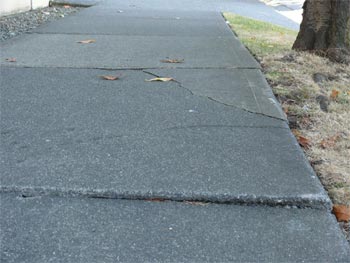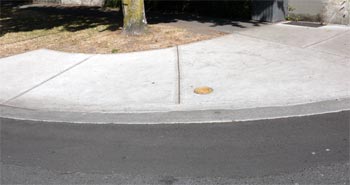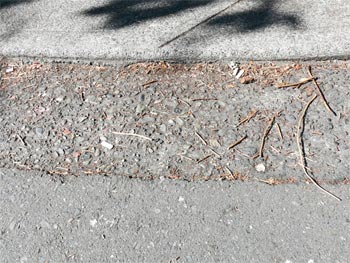Oct
14
Although we understand that accessibility is a big topic, we are focusing on sidewalks. Depending on the feedback we receive, future articles may expand sidewalk concerns, or we may move on to other mobility accessibility issues such as public buildings, parks, and washrooms.
By Rita and Ted Button
Photos by Rita nad Ted Button
Incredibly, Mother was right: "You don't know what you've got till it's gone."
Most of us take our mobility for granted. Of course we'll be able to walk to the store, get by that hydro pole on the sidewalk (actually, we probably didn't even notice the hydro pole), step off the curb-automatically stepping a little higher to avoid tripping on uneven surfaces-until one day, something happens, and we find ourselves taking tentative, unconfident steps behind our newly-acquired walkers, are in a wheelchair you or someone else is pushing, or are riding in a motorized scooter or wheelchair. Suddenly, the world has become a place where obstacles are the rule, rather than the exception.
In Canada, Victoria is often touted as the Promised Land. It's true: people, whose mobility difficulties shackle their access to the world, experience a reprieve in Victoria just because of the weather-no icy sidewalks or snow-banked curbs. The air doesn't hit your lungs like a knife the first time you take a breath upon stepping outside-even when the calendar says it's January! In stark contrast to Winnipeg, where we lived before gaining the wisdom to move here, a January walk to anywhere feels incredibly freeing and wonderfully easy.
Generally, life in this city is wonderful. My husband, Ted, and I have enjoyed the last thirty-four years we have lived in Victoria, the last nine of these in James Bay. There's no better place to be in Canada if you are confined to a wheelchair as Ted has been since 1998. With age comes the wisdom to live in a place that allows the living to be easy. Maybe that's why 22.7% of Victoria's population is older than 60. In James Bay, the number is even higher: 36.9% of the population is over 60, and of these, 17% is over the age of 75.
It seems our City Parents understand that Paradise is a part of a Victorian's mindset, since part of the City's mission, as stated on its website is "to maintain and enhance the quality of life in the city." Included in its vision for this enhanced quality of life is to "support walking in the city." In fact, the City would like to "increase the number of trips people make by walking"-and to achieve this goal, it is determined to make these walking trips safe. Great goals!
However, even in Paradise, accessibility issues surface-partly because of surfaces-if you're using a pedestrian path!
Of Victoria's 475 kilometers of sidewalks, curbs and gutters, many require repairing or modifications. It's not because the city doesn't want to get it done; they do, but like most of us, they have budget constraints.
It's partly because of the great weather that some of the issues occur. Hedges and bushes, for example, sometimes encroach onto sidewalk space-no big deal for the average person or pensioner using his/her two feet, but if you're the one in a wheelchair or pushing a walker, the narrowing sidewalks become a hazard. Now the person whose vision may also be less sharp than it once was, must negotiate around the extra greenery-almost not fair since the greenery is one reason we love it here!
Sidewalks have a tendency, even in salubrious weather, to heave and split, thereby impeding the safe progress of the challenged walker. Being unsure of what's beneath your feet becomes an issue. The particularly treacherous curbs, certainly for a manual wheelchair, are those that go uphill and have three different levels from the curb to the intersection.
The  angle at which the chair rolls over the levels is important as is the rate of travel-go too fast, and you might break an axle or throw the rider out of the chair; go too slowly, and you might not make it over the obstructions before the oncoming traffic screeches to a halt. Another is the jagged and uneven edges between the squares of concrete as tree roots encroach on man-made surfaces or as erosion takes its toll.
angle at which the chair rolls over the levels is important as is the rate of travel-go too fast, and you might break an axle or throw the rider out of the chair; go too slowly, and you might not make it over the obstructions before the oncoming traffic screeches to a halt. Another is the jagged and uneven edges between the squares of concrete as tree roots encroach on man-made surfaces or as erosion takes its toll.
Lately, we've noticed the improved curbs on some of the James Bay sidewalks such as the two on Oswego and Simcoe.
The  wheelchair rolls over these smoothly, and the idea of being careful not to break an axle or to jolt the passenger out of the wheelchair disappears entirely. We were so excited the first time we saw these that we wanted to roll over them repeatedly-they are fabulous! As well, we have noticed and appreciated the scraping down of eroded sidewalks in an attempt to smooth the way.
wheelchair rolls over these smoothly, and the idea of being careful not to break an axle or to jolt the passenger out of the wheelchair disappears entirely. We were so excited the first time we saw these that we wanted to roll over them repeatedly-they are fabulous! As well, we have noticed and appreciated the scraping down of eroded sidewalks in an attempt to smooth the way.
Other  curbs have a less elegant , but workable fix-a gob of blacktop has been placed in a smoothed-out ramp-like fashion, butting onto the sidewalk where the curb had previously been uneven and rough.
curbs have a less elegant , but workable fix-a gob of blacktop has been placed in a smoothed-out ramp-like fashion, butting onto the sidewalk where the curb had previously been uneven and rough.
These modifications help anyone who has difficulty negotiating his/her way on sidewalks. And even though we haven't expressed our gratitude, it is there every time we roll over the smoothed out areas.
The Pedestrian Master Plan can be found at the following url:
http://www.victoria.ca/EN/main/departments/engineering/transportation-planning/pedestrian-master-plan.html (full PDF version). Completed in 2008 by Opus Hamilton Consultants of Vancouver, and adopted by the City, this plan has the goal of improving the pedestrian experience. It recommends that the plan be updated every five years. In a meeting with two employees of the City's Planning and Engineering Department, we discovered that the actual budget to implement the plan is about half of what was initially recommended. As a result, the five-year update cycle for the plan is closer to ten years. The plan also prioritizes where new sidewalks will be created and is an integral part of all new planning and development activity.
The main managing tool for the Pedestrian Master Plan appears to be the Sidewalk Priority Index (page ES-6), comprised of two components: Pedestrian Potential Index and Deficiency Index. These Indexes assign a score to each potential location for a new or extended sidewalk. The resulting score, based on eighteen evaluating criteria, assists the City in determining which blocks should have priority for new sidewalks. Examples of the evaluating criteria are the following: Is the sidewalk on a transit route? Is it near a school? Do repeated pedestrian-related collisions occur in this area? How often has the problem been reported? The full list that is used to prioritize the order in which sidewalk improvements will be scheduled is stated on pages 28-29.
The public are also invited to report sidewalk-related issues by using any of the following methods: call the City Hall switchboard and leave a message-available 24/7: the number is 250-385-5711; call Public Works at 250-361-0400; call Public Yards at 250-361-0600; or fill out the online Service Request Form on the city's website using this link:
After you've made the report, a City worker checks the problem, and identifies the area with a swipe of bright paint. Next, it's assessed and scheduled for maintenance according to its assigned priority and cost.
It's good to know that the city wants the pedestrian experience to be safe for all. The meeting we had with the two members of the city's Planning and Engineering Department answered some of the questions that resulted from the research such as the extent to which the goals of the Pedestrian Master Plan had been met. The Mayor reports on the progress in his annual Letter; however, he does not go into the nitty gritty detail of which streets were improved and which have yet to be modified. Recently, a new facility, VicMap http://www.victoria.ca/EN/main/community/maps.html has been made available on the city's website. This interactive map allows people to find bus stops, parks, streets, etc., and could, eventually, map out public projects and initiatives such as sidewalk enhancement and repairs. Detailed tracking of projects and their progress/completion could also occur here. What an excellent communication vehicle this could become!
From the meeting, we also discovered that part of the challenge in measuring progress emanates from the fact that many different budgets are accessed in the sidewalk improvements issue. For example, repairs such as that of fixing a lifted square comes out of the Public Works maintenance budget. The Planning and Engineering Department manages the Capital Planning Budget of approximately $300,000 annually-about half of what was recommended in the 2008 Plan is used for new or enhanced sidewalk plans. Both people we talked to emphasized the importance and value of public input, which is, therefore, invited at initial planning stages, as well as at visits, open houses and presentations at neighbourhood association meetings. Close attention is paid to these comments that often change an aspect of a project, since through feedback, new ideas emerge.
The Neighbourhood Transportation Plan, dating back to 1996, also has a budget that impacts the installation of new sidewalks-this budget is responsible for the latest smooth sidewalk transition at Simcoe and Oswego, across from the James Bay Elementary School. As well, any large building project will affect the accessibility of sidewalks since plans are discussed and approved by the various City Hall departments using the principles of the Pedestrian Plan whose tentacles permeate all city building projects.
At our meeting, we also learned that priorities sometimes get changed because of new projects-especially massive underground projects that often create economies of scale opportunities so that the work of placing hydro poles underground, for example, may occur as a byproduct of another initiative, creating a win-win situation for all.
Thus, measuring progress against original plans becomes murky, at times. On the other hand, as we left the meeting, we felt assured that accessibility, not only for those with mobility issues but also for other issues such as vision and hearing, is always an important, integral part of the decisions when approvals for new initiatives occur.
James Bay is a great place to live. It is easy to see that the City is a positive element in everyone's continued efforts toward improving the quality of life in Victoria for all!
